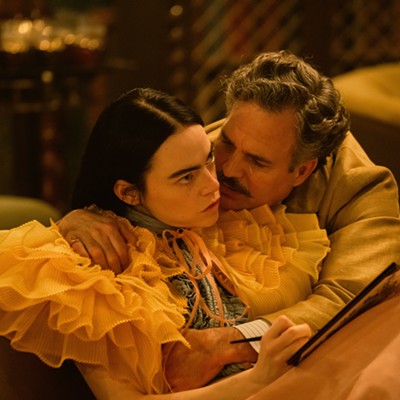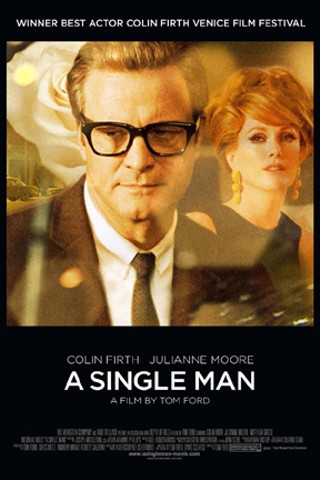I'll always remember Tom Ford as the man who shaved a Gucci symbol into a model's pubic hair. That was back when he worked in the fashion world, but these days Ford has higher aspirations than crotch fonts. Having left haute couture to fend for itself, he's switched to filmmaking, bringing along a striking visual sensibility, though not a great sense of pacing.
Ford's A Single Man is based on the novel by Christopher Isherwood, and set in L.A. in 1962. It begins with a car crash, or the dream-memory of a car crash. Jim (Matthew Goode), a 30-something architect, lies dead on an icy road, his eyes frozen open. Grief-stricken George (Colin Firth) arrives, kisses Jim on the lips, and then wakes up in his own bed.
For 16 years, George and Jim were a happy couple. They lived together in a glass house, throwing bones, and enjoyed as much of each other as two gay men could in the uptight world before the hippies came along and destroyed America by making it OK to have sex with people you loved. But with Jim dead, George is reduced to memory and grief, so one day he decides that it would be a good idea to catch up on some work, stop by the bank, visit an old friend, buy some bullets and blow his brains out.
At first, Ford does a good job of conveying the emotional weight that hangs around George's neck. Colin Firth gets up, stands in front of the mirror, and says, "You must get through this goddamned day," and every heart in the world breaks. The music is heavy and emotive, but not inappropriate. Ford selected musicians Shigeru Umebayashi and Abel Korzeniowski to create richly orchestrated pieces that sound like Bernard Hermann filtered through the most romantic moments in Beethoven.
The reason this isn't unpleasant in the usually manipulative Hollywood manner is that the music isn't a redundant punctuation to what's already been said in the dialogue. Instead, it forms a contrast with George's stiff-upper-lip outer life. While Firth keeps it very English, using proper diction in the most devastating moments, the music is like the voice-over of his unexpressed emotional life, explaining what parts of him have died, are dying, and will shortly die.
It helps that the score mostly doesn't play on top of the dialogue, but instead fills otherwise silent images of George's pained but socially acceptable facial expressions. Firth perfectly executes the difficult task of appearing to be in pain, but at the same time presenting an expression that would be unreadable to those who don't understand his life. He's helped by some inventive cinematography. When the camera takes George's point of view, the colors are muted, but then, occasionally, a figure in the foreground will jump into bright relief, lips reddening, skin becoming saturated with sunshine colors. I've never seen this use of chromatic technique before, and Ford, with his background in fashion photography, has a real knack for it.
One creature who stands out in George's gray-on-gray world is Kenny (Nicholas Hoult), one of the students George teaches in an English lit class at the local university. Kenny's sensitivity and weirdness makes him stand out in pre-hippie 1960s. Soon he's asking after George, trying to find out why he's so troubled, and aiming to reignite George's love of life. Basically, he's the first manic pixie boyfriend in film, a pretty, big-eyed creature who arrives to help the lead character with his feelings.
The imagery, the acting and the dialogue are all great, including some weird encounters that George has with passing Los Angelinos who offer their dogs and hips to try to tell help George cope. But ultimately, Single Man is flawed by its inability to find a strong narrative line, or to transcend its visual inventiveness. At times it seems like a collection of short films, any one of which would be excellent viewing, but which, taken together, become redundant.
This isn't a fatal flaw. A Single Man is still a strong picture; I just think that if Ford were as practiced at narrative as he is accomplished at conveying feeling through sound and color, Single Man would have been better. Still, the scenes of the owl of Minerva flying at 3 a.m., the pretty naked boy on the couch, the dead eyes of a frozen lover, all add up to thoughtful work that makes excellent use of two of cinema's central modalities, sound and image, even if it doesn't rise to the level of storytelling that movies alone, above books and songs and Superman comics, can reach.











